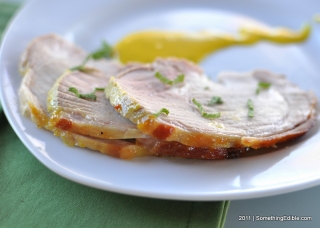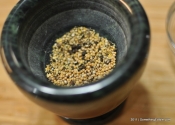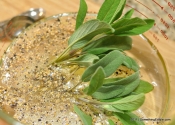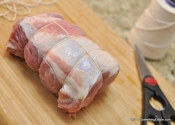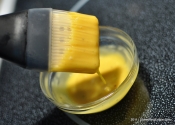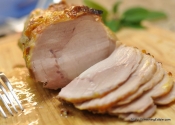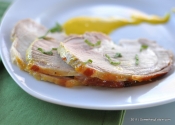Some food, some drink.
When Sunday dinner ain’t for a crowd: Honey Mustard-Glazed Pork Loin Roast.
Abstract: It makes a lot of sense to buy boneless pork loin in bulk when you're feeding a family, but buying a whole subprimal for center-cut chops defeats the purpose altogether. The ends of the loin found closest to to the shoulder and sirloin alike make for fantastic roasts that are perfect feasts for small families and/or modest appetites. This particular recipe uses a brine of honey, black pepper, mustard, and fresh sage to keep the meat flavorful and juicy; and is topped with a honey mustard glaze that doubles as a condiment.
Purpose: I've lamented
before about
the uphill battle I've got with getting my family to understand that
the meat they eat is more than the sum of it's parts. Back when I was a
biologist, we learned that gradual change is seldom gradual; and more
often change is a series of punctuated
events that when viewed over time seem gradual to the casual
observer. Such is
the case with my quest to get my family to eat more than just the
boneless, skinless portion of a critter.
To pick on my wife (Love ya sweetie) - ![]() When we first met, about
the only pork she would eat was a
boneless, skinless pork loin chop cut from the center of the loin.
As we grew into a family, it made sense to start buying bulk
packs of loin that we (read: me) would cut
ourselves. My Mrs. wanted no part
of the pig that wasn't lean and consistent in color, so I needed to
find a suitable use alternative for everything on the ends. In
most cases I found that there was enough "white
meat" on the last two pounds closest to the blade to placate the
family,
even if it wasn't all in the same cross section, so I started keeping
those ends whole to roast. Incidentally, these cuts turned out to
almost
always be about two pounds, which is the perfect size for our small
family's dinner.
When we first met, about
the only pork she would eat was a
boneless, skinless pork loin chop cut from the center of the loin.
As we grew into a family, it made sense to start buying bulk
packs of loin that we (read: me) would cut
ourselves. My Mrs. wanted no part
of the pig that wasn't lean and consistent in color, so I needed to
find a suitable use alternative for everything on the ends. In
most cases I found that there was enough "white
meat" on the last two pounds closest to the blade to placate the
family,
even if it wasn't all in the same cross section, so I started keeping
those ends whole to roast. Incidentally, these cuts turned out to
almost
always be about two pounds, which is the perfect size for our small
family's dinner.
Recipe: Jump to the detailed recipe. (or, keep reading for the gist of it) -
The Meat
The Brine
Honey Mustard Glaze/Dip
For the brine, add mustard seed, black peppercorns, honey, cider vinegar, garlic, sage, and Kosher salt to the water. Simmer the solution over medium heat long enough to dissolve the salt completely (it doesn't need to boil). Remove from the heat and add the ice. When the ice has dissolved completely (the brine temperature should be lower than 50F), place the brine and roast in a lidded plastic or glass containment vessel and refrigerate for 4 hours.
At the end of the brine session, pat the roast dry, tie or band the roast if desired, and let air-dry in the fridge on a rack (sitting atop a tray) for 30 minutes. Meanwhile, whisk together the ingredients for the glaze and refrigerate. After the air-dry, preheat the oven to 350F and place the roast on a panned roasting rack. Insert the cooking thermometer into the center of the roast and add a cup of water to the pan. Cook until the internal temperature reaches 90F (note: we ain't done cooking yet). Reserve a quarter cup of the honey mustard, and starting at that 90 degree mark, paint the roast with the glaze roast with every 10 degree increase in meat temperature until the pork reaches an internal temperature of 150F. Remove from oven, cover w/ foil and let rest for 15 mins before de-stringing and slicing.
Observation:
- If you attempt to do this roast without taking the time to brine, you're setting yourself up for disappointment. Just like the marketing states, this is the "white meat" of the hog. The striae of this muscle will bleed water like a - (well, you know) when heat is applied, and the lack of significant collagen and fat sure as hell don't make matters any better. The brine is your principal seasoning, and your insurance policy against overcooking.
- You don't wanna under-cook your roast either; which is why you
shoulda bought that probe thermometer
a long time ago. 'Tis always better to cook a roast by temperature and
not by time.
- A two pound roast will get our family thru two meals easily. However, If you have big eaters and you're doing a larger loin roast, you'll need to plan for approximately an hour of brine time for every half pound of meat.
- All that trussing business is completely optional, but it's not
like you even have to know how to tie
a knot anymore. That said, bundling the
meat into an even thickness means a more even cooking. However if
you're
the type of outfit that fights over the chewy, overdone bits, you go
right ahead and do
your own thang.
- On the subject of fat: If you can keep some fat cap here, by all means do it. This cut needs all the help it can get, which is also the reason why we use a glaze with plenty of fat in it.
- The glaze is added about halfway thru the roast because as being
one
third sugar, it's sure to burn.
- Incidentally, the recipe for the glaze makes extra for dipping
and the
like; which is a good thing, 'cuz people are gonna ask you for the
recipe (if you're one of the fifteen people that follow
my microblog, you already know what this stuff is).
- On the subject of the glaze, pleeeeeease remember to portion separately what you're
brushing over the roast and what you'll be using at the table.
"Underdone meat" and "double-dipping" are terms that shouldn't be used
in the same sentence, save for cautionary tales.
- I probably don't have to tell you that most food-borne
illness-fearing folk will not want to be served the roast at the
temperature at which you're pulling it from the oven. Calling the last
15 minutes a "rest" is a bit of a misnomer, as the pork will continue
to cook and raise in temperature about another 10 degrees as it sits
covered
on the counter. What's more, the muscle
fibers are wound tight from all that heat stress and have wrung their
juices like a washcloth. As the meat rests, muscle fibers will
relax, juices will
redistribute, and your dining experience will be better for it.
- If you wanna roast on your grill, by all means have at (I
understand certain
types of barbeque grills are also really good at roasting as
well). I
would have lit my gas grill for this one had it not been snowing in the
middle of
April. I love Kansas. :-p
Results: My family has come a long way with what they will and won't tolerate on their plate. As it happens, another punctuated event in the family gastronomic annals was the premise for my making this roast (gotta clean out that freezer!). This is the kind of Sunday dinner I like to do when I know we're not having company and I still want to make dinner a little special. That's not to say that I wouldn't serve it to company; it's just that this roast doesn't make a whole heck of a lot. All the same, there's not much to be fussy about, which makes this moist and flavorful roast the perfect centerpiece to a lazy Sunday when everyone's got a little time to wait for dinner.
Gallery:
For the brine, mustard and peppercorns just need to be cracked. A baggie and a rolling pin will work too.
For the brine, mustard and peppercorns just need to be cracked. A baggie and a rolling pin will work too.
If fresh sage isn't available, the dry stuff will do. As dry herbs are more concentrated, I reckon two teaspoons should be plenty.
If fresh sage isn't available, the dry stuff will do. As dry herbs are more concentrated, I reckon two teaspoons should be plenty.
If someone would have told me that I was actually going to need to know how to tie a knot later in life, I wouldn't have dropped out of Cub Scouts when…
If someone would have told me that I was actually going to need to know how to tie a knot later in life, I wouldn't have dropped out of Cub Scouts when I was ten.
Less than four minutes left in our fifteen minute rest, and we've gone up nine degrees from when we took it out of the oven.
Less than four minutes left in our fifteen minute rest, and we've gone up nine degrees from when we took it out of the oven.
I guarantee that you'll make good on that fifteen-minute investment of patience. This roast is ju-u-uicy, and you can cut it with a fork.
I guarantee that you'll make good on that fifteen-minute investment of patience. This roast is ju-u-uicy, and you can cut it with a fork.
Get Social
Please wait while my tweets load...
Get the latest recipes and news. Join our Facebook page!



